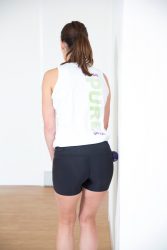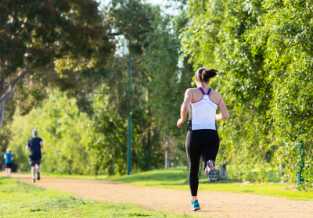Week 5: Great Ocean Road Running Festival 2017
Published on
27 Mar 2017

Call us on: (03) 9975 4133
Foam rollers and Spikey balls hold pride of place in the lounge rooms of most runners often to the annoyance of other houseguests – their bright colours do tend to clash with the decor. But any runner would tell you a foam roller is a runner’s best friend
My Favourite Spikey Ball and Foam Roller Techniques!
Foam rollers and spikey balls are a form of self-myofascial release/self massage, which helps release adhesions in your muscle and connective tissue. Studies have also revealed that foam rolling helps increased blood flow, which helps recovery and mobility. So what should you foam roll? This week I have made a list of a few of my favourite foam rolling techniques for you to try during your 2017 Great Ocean Road Marathon training!
1. Calf Release (foam roller):
The calf muscle is responsible for absorbing load and creating propulsion forward over the ground when we run. Distance running therefore places a high load on the calf muscle. Athletes who are trying to increase the speed of their running or transitioning into a more forefoot running technique will be very familiar with tight calves.
Avoid rolling down onto your Achilles or too high behind your knee. You tibialis posterior is located near the inside of your calf and always appreciates a good release – similarly to your outer calf where your peroneal muscle bellies live. Rotate your foot in or out to access these areas on the foam roller.
TIP: to increase the pressure cross one foot over the other.

2. Lateral Quads (foam roller):
ITB release is well known for the pain it can inflict when rolled. I personally prefer to stay off my ITB as it is essentially an inelastic structure. Instead, roll the outer quad and release the TFL muscle (below). The muscles have communication with the fascia of the ITB and are a little more tolerable.

3. Upper Back (foam roller):
Unfortunately the modern world of desk based work means we sit a lot more then we should. As a result our upper back gets quite tight. Although the back may seem far from where the main work is taking place the stiffer your upper back the greater the neural and torsion load transfer to other areas of your body.

4. Glut med and TFL release (spikey ball):
The Spikey ball is the best tool to release the muscles around the top of your hip. These muscles have a very important stabilisation role in running and often get quite tight when building the miles. Using the ball against the wall or floor to create even more pressure is an effective way to help take away the muscular tension.

We’re Here to Help!
After your next run check out a few different techniques and see how you feel! Don’t forget, we’re always here to help so why not come in for a session with our rehab physios to find the perfect technique for you!
Week 5: From the 27th of March
Tuesday – Fartlek/Interval
– Warm up 10mins (2km)
– 5 mins, 4 mins, 3 mins, 2 mins, 1 min (90 sec recovery)
– Cool Down (3km)
= 8km
Thursday – Fartlek/Interval
– Easy 8km jog
= 8km
Saturday – Hills/Tempo
– Warm up 15 mins (3km)
– 12mins tempo through rolling hills (3 mins easy jog), 4 mins tempo 4 x 100m hills,
– Cool Down (3km)
= 9km
Sunday Long Run
– 13km
= 13km
Total kms = 38km for Week 5!


